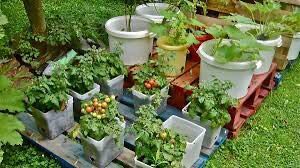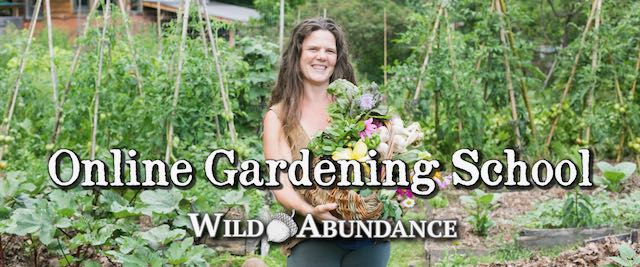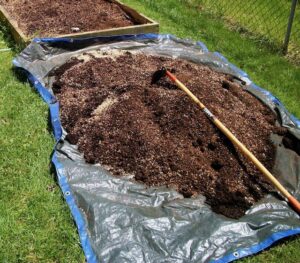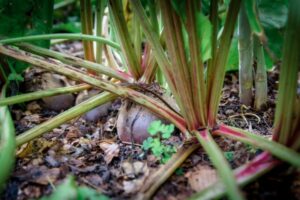Homegrown fruits and vegetables taste great from garden to table. They let you tune up your green thumb and palate at the same time. Land-based living and working toward an environmentally sustainable world gives you more control of what you eat. Whether you garden in a full-sized plot or a set of containers, using the best soil leads to tasty and healthy vegetables, herbs, and fruits.


While it may seem easier to start fresh with a “soilless” growing medium, you can Do It Yourself with a combination of organic material and inorganic components. The soil absorbs moisture while draining well and providing air space for roots to grow.
Repurposed Soil
It’s tempting to take soil from the yard or garden and plop it into containers. But the soil may be contaminated with pests, pathogenic fungi and bacteria, or weed seeds. Additionally, garden soil tends to be too heavy for containers, not draining well or allowing for proper airflow.
Garden soil needs to be amended before you can use it in confined areas. Add grass, pine bark fines, coco coir, or other organic matter to improve the soil texture. Coarse sand and/or perlite helps with drainage. Kill off pathogens and weed seeds from garden soil by heating it in the oven at about 180 degrees for 30 minutes. Don’t be tempted to bake it at a higher temperature, though: Heating soil at 200 degrees or higher can release toxins into the air. Alternately, you can lay the soil out in direct sunlight, in a thin layer, for a couple of days. The UV light will breakdown most pathogens, however weed seeds may persist.
Other Ingredients for Container Garden Growing Mediums
Coco Coir
This is basically shredded up coconut hulls and is considered a more sustainable alternative to sphagnum peat moss, which is removed from sensitive peat bog habitats. Coco coir offers no nutrition, but provides good structure and water-holding capacity.
Sand
The cheapest and easiest-to-get-ahold-of option for increasing drainage in a growing medium.
Sphagnum Peat Moss
Peat moss is a very common ingredient in pre-mixed growing mediums and the nursery trade. It’s great at holding moisture and improving texture and behaves very similarly to coco coir. We don’t choose to use it because it’s extracted from sensitive peat bog ecosystems in a way that is disruptive and unsustainable. If you do choose to use peat moss, be aware that it’s slightly acidic.
Perlite/Vermiculite
These are both naturally occuring forms of “puffed” rock that are formed under high heat and pressure in the earth’s crust. They’re mined, but they are also abundant. Some people consider them very sustainable, while others question the mining and distribution systems. They act to improve both drainage and water-holding capacity of growing mediums.
Compost
Whether it’s made from manure or is plant-based, compost adds fertility, organic matter, humus, and both water-holding and drainage to growing mediums. All container gardening mixes contain compost — it’s a must-add ingredient.
Worm Castings or Vermicompost
Earthworm or “compost worm” droppings are rich in micronutrients and humic acid. They improve texture and also help overall plant health. If you have access to worm castings/vermicompost, they will boost your growing medium and make your plants happy.

Growing Medium Recipes
Chloe’s Easy Option from our Online Gardening School
- 1 part pre-moistened coco coir
- 1 part composted manure
- 1 part pine bark fines (a.k.a “soil conditioner”)
- 1 part worm castings/vermicompost (depending on availability)
From the Anne Gibson, The Microgardener
- 1 part pre-moistened coco coir
- 1 part grade 3 vermiculite or course sand
- 2 parts sieved compost
- 1 cup to 1 part worm castings/vermicompost (depending on availability)
From the Gayla Trail, You Grow Girl
- 2 parts rehydrated coco coir
- 2 parts sieved compost
- 1 part coarse sand (builder’s), grit, and/or perlite
- 1 part vermiculite (optional, but I like it for water absorption)
Soil-based blend from Planet Natural
- 1 part peat moss or mature compost
- 1 part garden loam or topsoil
- 1 part clean builder’s sand or perlite
About Soil pH
Soil alkalinity or acidity is noted on a pH scale of 1 to 14. Soil at 7.0 is neutral. Below that number is acid (sour) soil. Above 7 and the soil is alkaline (sweet). Different plants will like different soils, however most garden vegetables prefer close-to-neutral pH, and will tolerate slightly acidic soil.
If the pH is too high or too low, nutrient availability may be compromised. Since container gardening doesn’t allow for nutrient mobility and drainage in the same way that growing in the ground does, pH can fluctuate more in containers.
Whether you’re planting in a traditional garden, a rain garden, or in containers, test the soil. This will give you a good sense of the pH, along with what nutrients are present in the soil.
When pH is too high, you may see yellow foliage and stunted growth because iron can’t reach the root system. If the cause isn’t root rot or low nitrogen, chances are that there’s an off-balance pH, or the soil has too much lime added to it. If pH is too low, many plants won’t germinate or won’t grow well.
Sunlight
Garden vegetables need six or more hours of direct sunlight each day. Outdoor containers can be moved as the sun shifts, but that takes time and effort. One way to determine the amount of sunlight your container location receives is to draw an hourly diagram and mark off which times have direct sunlight, partial shade, and full shade. When planting fruits, vegetables and herbs, place the containers in a southern exposure to receive the most sunshine (if you’re in the southern hemisphere, you’ll want northern exposure).
Growing healthy plants, fruits, and vegetables depends on soil, sunlight, water, and a little bit of Mother Nature’s magic. Container gardens let you reap the benefits all year long. Bring them inside during cold winter temperatures and put them under a plant light. The best part about container gardens? They’re portable. To learn more about container gardening, and gardening in general, join us for the Online Gardening School.
This is a guest-post by contributor Cynthia Stern. She is a landscaping and gardening writer who has a passion for decorating outdoor living spaces.



